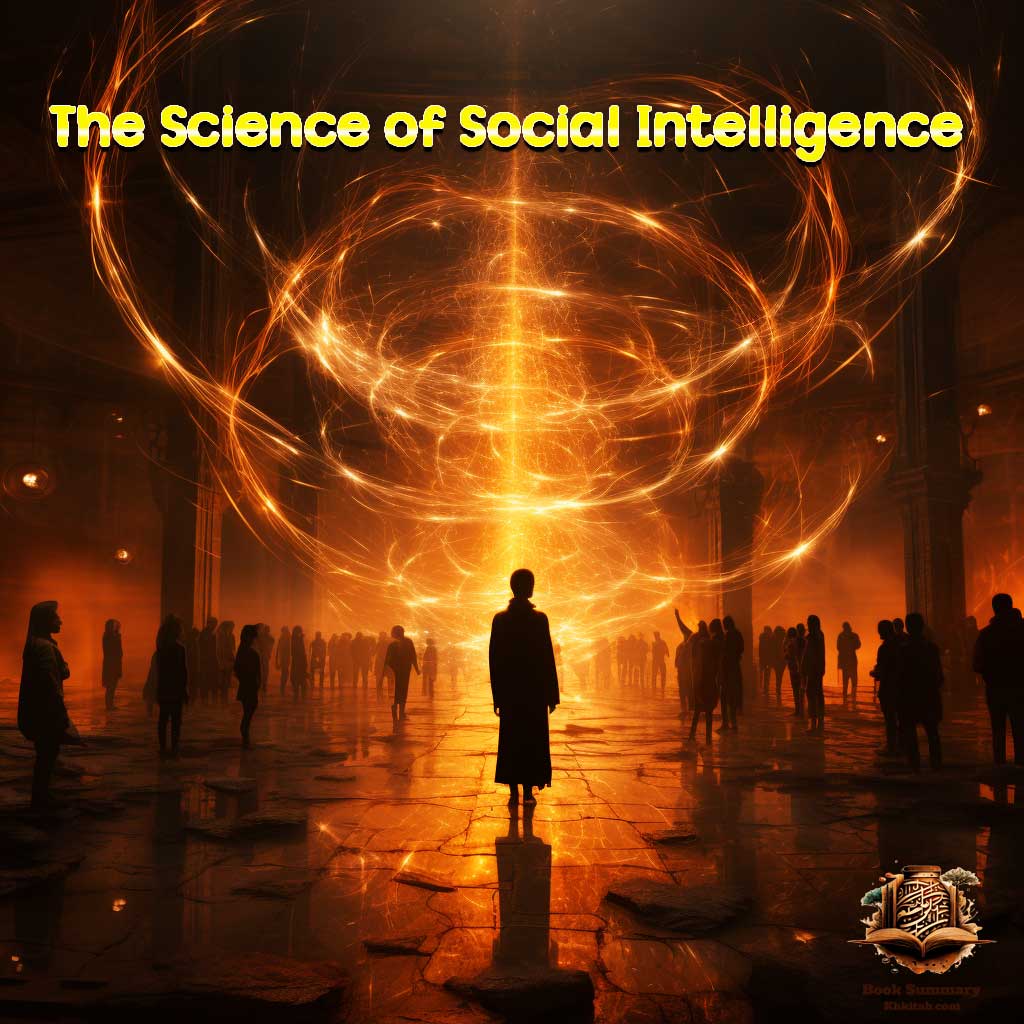The Science of Social Intelligence: 33 Studies to Win Friends, Be Magnetic, Make An Impression, and Use People’s Subconscious Triggers Book Summary

In today’s interconnected world, social skills have become a paramount element for personal and professional success. The book, “The Science of Social Intelligence: 33 Studies to Win Friends, Be Magnetic, Make An Impression, and Use People’s Subconscious Triggers,” offers a profound and innovative insight into enhancing our daily interactions and building more meaningful, stronger relationships.
Authored by Patrick King, this tome delves into a myriad of scientific studies that unveil the psychological and sociological factors influencing our social presence and how people engage with us. The aim is to help readers decode the secrets of social magnetism and apply them effectively in their day-to-day lives.
For those keen on refining their social prowess, or understanding the intricate mechanics governing human interactions, this book stands as an exemplary guide to comprehending the complex dynamics of social relationships and positively influencing them.
How Does Understanding Social Dynamics Shape Our Interactions and Relationships?
In the realm of personal and professional growth, comprehending the intricate web of social dynamics is pivotal. “The Science of Social Intelligence: 33 Studies to Win Friends, Be Magnetic, Make An Impression, and Use People’s Subconscious Triggers (The Psychology of Social Dynamics)” provides readers with a deep dive into the nuances of human interactions and relationships.
Understanding social dynamics is not merely about recognizing the patterns of human behavior. It’s about grasping the underlying principles that govern these patterns. At the heart of these principles lies the notion that every individual seeks connection, validation, and a sense of belonging. This powerful drive shapes our interactions, often in ways we might not consciously realize. For instance, the choices we make, from the words we use in a conversation to the way we respond to social cues, can either enhance or hinder our connections with others.
By delving into the mechanics of social dynamics, we begin to see the invisible threads that link us together. These threads, whether they’re formed from shared experiences, common goals, or mutual understandings, serve as the foundation for strong, lasting relationships. Furthermore, recognizing the ebb and flow of these dynamics can lead to better communication, deeper empathy, and a heightened ability to influence and persuade.
In essence, the journey to mastering social dynamics is a transformative one. It not only equips individuals with tools to navigate social settings more effectively but also offers a roadmap to building authentic relationships that stand the test of time. Through “The Science of Social Intelligence,” readers are invited to embark on this journey, enriching their lives and the lives of those they interact with.
Our Facebook Page – Book Summary
How Do Subconscious Triggers Shape Our Interactions and Perceptions in Social Dynamics?
In the interconnected tapestry of human relationships, subtle cues often exert profound influences. “The Science of Social Intelligence: 33 Studies to Win Friends, Be Magnetic, Make An Impression, and Use People’s Subconscious Triggers (The Psychology of Social Dynamics)” masterfully deciphers these undercurrents, highlighting how subconscious triggers play pivotal roles in shaping perceptions and responses in social environments.
Subconscious triggers, as explored in the book, are those nuanced, often unnoticed stimuli that steer our emotions, thoughts, and behaviors in specific directions. They can stem from past experiences, cultural norms, or even evolutionary predispositions. For example, a particular tone of voice or facial expression can evoke feelings of trust or distrust, influencing our willingness to connect with someone.
One of the most compelling aspects of these triggers is their universality. Regardless of cultural or geographical boundaries, certain triggers, like the instinctual response to a genuine smile or the inherent trust in consistent behaviors, remain universally influential. This universality underpins the magnetic allure of individuals who can adeptly navigate these cues to forge deeper connections, leave lasting impressions, and even persuade with ease.
Moreover, by understanding and harnessing the power of these triggers, one can not only navigate social landscapes more effectively but also foster genuine relationships and influence others in positive and constructive ways. The essence of mastering these psychological underpinnings lies in self-awareness. It’s about recognizing one’s own triggers and understanding how they intersect with those of others. By doing so, individuals are better equipped to communicate, empathize, and lead in diverse social settings.
In conclusion, the realm of subconscious triggers is vast and intricate. But by diving deep into its intricacies, as “The Science of Social Intelligence” does, we can better position ourselves to thrive in social contexts, enriching our relationships and broadening our influence.
Life Sciences & Medicine – Book Summary (khkitab.com)
How Can One Master the Art of Leaving an Unforgettable First Impression?
In the intricate world of human interactions, the first impression plays a pivotal role in how people perceive us and establish a basis for future interactions. Drawing insights from the enlightening book, “The Science of Social Intelligence: 33 Studies to Win Friends, Be Magnetic, Make An Impression, and Use People’s Subconscious Triggers”, it becomes evident that the art of creating a powerful first impression is not only about appearance but deeply intertwined with understanding human psychology.
Subconscious triggers, as discussed in the book, have a profound influence on our initial perceptions. A simple gesture, the tone of voice, or even eye contact can set the tone for an interaction. People often make judgments within the first few seconds of meeting someone, and those judgments, once formed, can be hard to alter. This emphasizes the importance of being genuinely present during interactions, exhibiting active listening, and maintaining appropriate body language.
Furthermore, the book highlights the significance of authenticity. While it might be tempting to put on a facade or adopt a persona that we believe others might find attractive, in the long run, genuine authenticity resonates more deeply with people. It fosters trust and lays the foundation for genuine relationships.
Moreover, understanding the dynamics of social cues, like recognizing when someone is interested or disengaged, allows one to navigate conversations more effectively, ensuring the dialogue is mutually beneficial and captivating. Employing strategies like asking open-ended questions or showing empathy can amplify the impact of the first impression.
In conclusion, mastering the art of a magnetic first impression is a culmination of various factors – from understanding subconscious triggers to being genuinely authentic. As “The Science of Social Intelligence” emphasizes, with the right strategies and awareness, anyone can harness the power to leave an indelible mark in any social setting.
How Can You Cultivate Charisma Through the Science of Social Intelligence?
In “The Science of Social Intelligence: 33 Studies to Win Friends, Be Magnetic, Make An Impression, and Use People’s Subconscious Triggers (The Psychology of Social Dynamics)”, a deep dive is taken into understanding the intricate balance between our conscious actions and subconscious triggers that shape our interactions. One of the paramount elements touched upon is the concept of charisma or personal magnetism.
- Understanding the Power of Presence: Charisma isn’t just about what we say, but how fully engaged we are when saying it. Engaging in active listening, maintaining eye contact, and being genuinely interested in what someone else has to say are fundamental components of charismatic individuals.
- Mastering Non-Verbal Communication: Our body speaks volumes, often louder than words. Charismatic individuals are often experts in conveying confidence and comfort through their posture, gestures, and facial expressions. They resonate warmth and openness, inviting others into their space.
- Vocal Variety: The pitch, tone, and pace of one’s voice can be a powerful tool in conveying passion, interest, and authenticity. Charisma often stems from the ability to tell a story in a captivating manner, holding the listeners’ attention throughout.
- Empathy and Emotional Intelligence: Truly charismatic individuals can tune into the emotions of those around them. They possess an uncanny ability to read the room and adapt accordingly. They acknowledge emotions, show genuine concern, and often act as a comforting or motivating presence.
- Genuine Self-Assuredness: Confidence is compelling, but it’s essential to distinguish between arrogance and genuine self-assuredness. Charismatic individuals believe in themselves and their abilities without feeling the need to diminish others.
- Authenticity: People are naturally drawn to genuine individuals. In the age of pretense, showcasing genuine emotions, beliefs, and vulnerabilities sets charismatic people apart.
- Subconscious Triggers: The book delves deeply into how subtle cues can have significant impacts. By understanding and harnessing these subconscious triggers, one can guide interactions in favorable directions, creating connections and leaving lasting impressions.
Cultivating charisma, as elaborated in “The Science of Social Intelligence,” is an art and science combined. It requires self-awareness, understanding human psychology, and practicing specific techniques and strategies. Through this comprehensive understanding, individuals can enhance their personal magnetism, drawing people towards them and leaving an indelible mark on their interactions.
How Can The Science of Social Intelligence Guide You to Build Strong and Genuine Connections?
In the comprehensive book, “The Science of Social Intelligence: 33 Studies to Win Friends, Be Magnetic, Make An Impression, and Use People’s Subconscious Triggers (The Psychology of Social Dynamics),” there is a wealth of knowledge that discusses the intricate dance of human connection. Establishing genuine relationships and fostering strong bonds is an art cultivated through understanding and applying certain principles. Here’s a deep dive into some of these pivotal approaches:
- Active Listening: This is not just about hearing the words, but truly understanding and empathizing with the emotions and messages behind them. The book emphasizes that most strong connections are built when people feel heard and understood.
- Vulnerability and Authenticity: To foster meaningful connections, it’s essential to show your true self, flaws and all. Authenticity breeds trust, and trust is the cornerstone of any strong relationship.
- Understanding Non-Verbal Cues: Almost 70% of our communication is non-verbal. Being aware of body language, facial expressions, and tone of voice can provide profound insights into a person’s feelings and thoughts, which can strengthen bonds.
- Emotional Intelligence: This involves recognizing, understanding, and managing our emotions while also recognizing, understanding, and influencing the emotions of others. High EQ individuals are better at navigating social environments and building deeper connections.
- Consistency and Reliability: As highlighted in the book, being someone others can count on is invaluable in relationship-building. Consistency in behavior and following through on promises establishes trust over time.
- Shared Experiences: Engaging in activities or facing challenges together can be a quick route to bonding. These shared experiences create memories and stories that serve as the foundation for a strong relationship.
- Subconscious Triggers: The book delves into how underlying triggers can influence our perceptions and interactions. By understanding these, one can create a more conducive environment for genuine connections.
- Ask Open-Ended Questions: These types of questions encourage dialogue and help to uncover layers of a person, leading to deeper understanding and connection.
- Empathy and Compassion: Seeing the world through another person’s perspective, feeling their emotions, and acting with kindness can bridge many gaps, forming bonds that are difficult to break.
- Continuous Learning and Adaptation: Social dynamics are ever-evolving. To maintain and enhance connections, one must be open to learning and adapting, which the book presents through various case studies and research findings.
In conclusion, “The Science of Social Intelligence” offers readers a roadmap to building stronger, more genuine connections. By understanding the psychological and subconscious factors at play and by mastering the art of interpersonal relationships, one can foster bonds that not only last but also enrich our lives in immeasurable ways.
How Can Empathy Amplify Your Social Intelligence and Foster Deeper Connections?
In the modern age, there’s a growing emphasis on the science behind effective social interaction, and “The Science of Social Intelligence: 33 Studies to Win Friends, Be Magnetic, Make An Impression, and Use People’s Subconscious Triggers (The Psychology of Social Dynamics)” delves deep into the intricacies of human connection. One significant theme within this rich tapestry of social dynamics is the incredible power of empathy. Here’s a comprehensive exploration:
- Empathy as the Cornerstone of Social Intelligence: Empathy is the ability to understand and share the feelings of another. This foundational skill allows individuals to predict others’ reactions, discern hidden emotions, and respond in socially adept ways.
- Deepening Connections: Empathetic listening involves not just hearing words but understanding and feeling what another person is experiencing. This depth of understanding fosters trust, a vital ingredient in any strong relationship.
- Conflict Resolution: People are more likely to navigate disputes smoothly when they approach situations with empathy. By understanding where another person is coming from, it becomes easier to find common ground.
- Facilitating Open Communication: When individuals feel understood and valued, they’re more likely to open up and share more about themselves. Empathy paves the way for more honest and profound discussions.
- Recognition of Non-Verbal Cues: A significant portion of our communication is non-verbal. An empathetic person is attuned to these cues, catching subtle hints from body language, tone, and facial expressions which might otherwise go unnoticed.
- Enhancing Group Dynamics: In group settings, those with high levels of empathy tend to foster a more inclusive and harmonious atmosphere. They’re often the mediators, the peacekeepers, and the ones who ensure everyone feels seen and heard.
- Empathy and Leadership: Effective leaders are often those who can put themselves in the shoes of their team members. Empathy enables leaders to motivate, inspire, and create environments where people thrive.
- The Role of Empathy in Influence: Understanding others’ perspectives and feelings can be a powerful tool in persuasion, guiding individuals to see things in a new light.
- Empathy and Personal Growth: Engaging with empathy not only benefits our relationships with others but also promotes introspection. It encourages individuals to question and expand their perspectives, fostering personal growth.
- The Subconscious Triggers: The book highlights how our subconscious plays a role in our interactions. Empathy can help in decoding these subconscious cues, making interactions more genuine and less driven by hidden agendas.
In conclusion, “The Science of Social Intelligence” makes it clear that empathy isn’t just a feel-good skill; it’s a powerful tool in the world of social dynamics. Harnessing the power of empathy can transform the quality of connections, turning surface-level interactions into profound bonds. In an age where genuine human connection can sometimes feel scarce, empathy is the bridge that spans the divide, creating understanding, acceptance, and unity.
How Can Effective Communication Elevate Your Social Intelligence?
Effective communication is an integral component of social intelligence. The book, “The Science of Social Intelligence: 33 Studies to Win Friends, Be Magnetic, Make An Impression, and Use People’s Subconscious Triggers (The Psychology of Social Dynamics)” delves deep into the art of communication and its crucial role in human interactions. Let’s uncover the key takeaways on this subject:
- Clarity in Expression: One of the foundational pillars of effective communication is the ability to convey thoughts and ideas in a clear, concise manner. The book emphasizes that by eliminating ambiguity, individuals can prevent misunderstandings and foster a more harmonious social environment.
- Active Listening: Beyond just speaking, the book underscores the importance of active listening. By truly hearing and understanding what another person is communicating, one can respond more empathetically and accurately, enhancing the depth of personal connections.
- Non-verbal Communication: Often overlooked, non-verbal cues such as body language, facial expressions, and tone of voice can sometimes convey even more than words. The book sheds light on how being attuned to these signals can provide a richer understanding of others’ emotions and intentions.
- Feedback Mechanism: Effective communication is a two-way street. The importance of giving and receiving feedback is highlighted as a means to continuously improve our communication skills and to ensure mutual understanding.
- Barrier Removal: Recognizing and breaking down communication barriers, be it cultural, linguistic, or emotional, is vital. The book provides insights into identifying these barriers and strategies to navigate them.
- The Role of Empathy: Communication is enhanced when it’s underpinned by empathy. By placing oneself in another’s shoes, it becomes easier to convey messages in a manner that resonates and is receptive to the other’s perspective.
In essence, “The Science of Social Intelligence” posits that mastering effective communication skills is paramount in the modern age. It’s not just about speaking, but also about listening, understanding, and responding in a way that strengthens bonds, builds trust, and fosters mutual respect.
How Can “The Science of Social Intelligence” Guide You Through Different Social Settings?
The art of gracefully maneuvering through diverse social situations is a coveted skill. Drawing insights from “The Science of Social Intelligence: 33 Studies to Win Friends, Be Magnetic, Make An Impression, and Use People’s Subconscious Triggers,” let’s delve into some prominent techniques that can equip an individual with the finesse to adapt and thrive in varied social environments.
- Understanding Social Dynamics: The book emphasizes the importance of comprehending the undercurrents of group interactions. Recognizing power dynamics, group norms, and the unspoken rules can drastically improve one’s navigation through social settings.
- Active Observation: Before plunging into a social situation, the value of being an astute observer cannot be overstated. Monitoring the room, understanding the mood, and gauging the dynamics can help in making informed decisions about how to approach and engage.
- Adapting Communication Styles: Different social settings demand varied communication styles. Whether you’re at a formal business meeting, a casual get-together, or an intimate conversation, understanding the tone and modulating your communication style accordingly can be immensely beneficial.
- Leveraging Emotional Intelligence: Emotional intelligence, a cornerstone of social intelligence, is about being attuned to one’s own emotions and those of others. The book discusses techniques for reading emotional cues, which can guide one’s actions and reactions in social situations.
- Setting Boundaries: Not every social situation will be comfortable. The book offers strategies for setting boundaries, ensuring that while you’re pushing your social comfort zone, you’re not overstepping personal limits.
- Using Subconscious Triggers: The understanding and application of subconscious triggers, as highlighted in the book, can be pivotal. These triggers can influence perceptions, making one appear more approachable or authoritative as the situation demands.
- Continuous Learning: Social dynamics are ever-evolving. The book accentuates the significance of being a lifelong learner, constantly updating one’s social toolkit, and staying updated with shifting societal norms and expectations.
In summary, “The Science of Social Intelligence” offers a comprehensive guide for individuals wishing to enhance their social prowess. By understanding and applying the principles laid out in the book, one can confidently navigate a spectrum of social scenarios, from networking events and team meetings to family gatherings and casual outings.
How Can “The Science of Social Intelligence” Guide Your Adaptability in Diverse Social Interactions?
In today’s fast-paced world, the ability to adapt one’s behavior to suit various social contexts and individuals is paramount. “The Science of Social Intelligence: 33 Studies to Win Friends, Be Magnetic, Make An Impression, and Use People’s Subconscious Triggers” delves into this concept, offering readers a treasure trove of insights and actionable steps. Here are some key takeaways from the book on enhancing adaptability in social interactions:
- Understanding Social Dynamics: The book emphasizes the importance of recognizing the subtle ebb and flow of social interactions. By comprehending the unwritten rules and group dynamics, one can adjust their behavior and communication style accordingly.
- Active Listening: This isn’t just about hearing words but understanding the emotions and motivations behind them. The book highlights that by actively listening, you can better gauge the mood and requirements of a conversation, allowing you to adapt your responses seamlessly.
- Emotional Intelligence (EQ): EQ is a recurrent theme in the book. It relates to understanding one’s own emotions and those of others. By developing EQ, you can read the room better, understanding when to push forward or when to hold back.
- The Power of Non-verbal Cues: A significant portion of our communication is non-verbal. The book underscores the importance of reading and adapting to these cues, be it body language, tone of voice, or facial expressions.
- Using Subconscious Triggers: By understanding what drives people subconsciously, you can tailor your approach to resonate with them. The book introduces several subconscious triggers and explains how to leverage them to be more adaptable in conversations.
- Cultural Sensitivity: In a globalized world, the chances of interacting with individuals from diverse cultural backgrounds are high. The book touches upon the significance of cultural adaptability, stressing the need to understand and respect different social norms and practices.
- Continuous Feedback: Taking feedback isn’t just for the workplace. By seeking and processing feedback from trusted peers about your social interactions, you can identify areas of improvement and adapt more effectively in future interactions.
- Being Present: One of the book’s valuable lessons is the emphasis on being in the moment. By being genuinely present in an interaction, you can better sense the nuances and adjust your approach in real-time.
In conclusion, “The Science of Social Intelligence” offers a comprehensive blueprint for individuals looking to navigate the intricate maze of social interactions adeptly. By understanding and applying the principles laid out in the book, one can confidently traverse a myriad of social situations, adapting and connecting with a diverse range of individuals. Whether you’re a seasoned networker or someone looking to improve their social prowess, this book provides tools and techniques to enhance your adaptability quotient in social interactions.
How Can “The Science of Social Intelligence” Help You Apply Psychological Insights to Elevate Your Social Skills?
“The Science of Social Intelligence: 33 Studies to Win Friends, Be Magnetic, Make An Impression, and Use People’s Subconscious Triggers (The Psychology of Social Dynamics)” is a book that offers a comprehensive guide to anyone aspiring to deepen their social connections by understanding and leveraging the intricate tapestry of human behavior. Applying the findings from these studies can drastically reshape how one navigates various social terrains. Here’s a breakdown of some of the key insights:
- The Subconscious Mind’s Power: A large portion of our social reactions stem from subconscious processes. By understanding these subconscious triggers, one can predict, and to a degree, influence the reactions of others, paving the way for smoother interactions.
- Principle of Reciprocity: One of the primary psychological tenets detailed in the book is that humans inherently feel the need to return favors. Recognizing this can be leveraged in interactions to build rapport and mutual respect.
- First Impressions: The studies show the monumental importance of first impressions and their lasting effects. Crafting a positive initial interaction can set the stage for beneficial long-term relationships.
- Body Language Mastery: More than just spoken words, our body language communicates volumes about our feelings and intentions. Recognizing these non-verbal cues and adjusting one’s own can significantly enhance communication efficacy.
- The Social Proof Phenomenon: People often look to others when making decisions. Being aware of this principle can help in understanding group dynamics and leveraging the behavior of the majority to influence a particular social outcome.
- The Likability Factor: The book sheds light on certain universally appealing traits and how embodying these can lead to being perceived more positively across different social settings.
- Emotional Intelligence (EQ): A recurring theme, EQ, or the ability to recognize, understand, and manage our emotions and that of others, is fundamental. The studies underscore its paramount importance in social situations, more so than even IQ.
- Adaptability: A critical aspect of social intelligence is the capacity to adapt to various personalities and situations. The book offers strategies derived from psychological studies to foster this adaptability.
- The Influence of Environment: How environmental factors, like settings or mood, can impact interactions, and how one can adapt to or even shape these environments for more favorable outcomes.
- Feedback Mechanism: Continual improvement comes from actively seeking feedback about one’s social interactions and using it as a learning tool. The book highlights the psychological basis for this and the best methods to employ.
In conclusion, “The Science of Social Intelligence” is an invaluable resource for anyone looking to boost their social prowess. By incorporating the psychological insights presented in these 33 studies, individuals can better understand the nuances of human interaction, allowing them to be more magnetic, impactful, and adept in their social endeavors.









التنبيهات : How to Succeed with People: Mastering Influence & Motivation - Book Summary Library